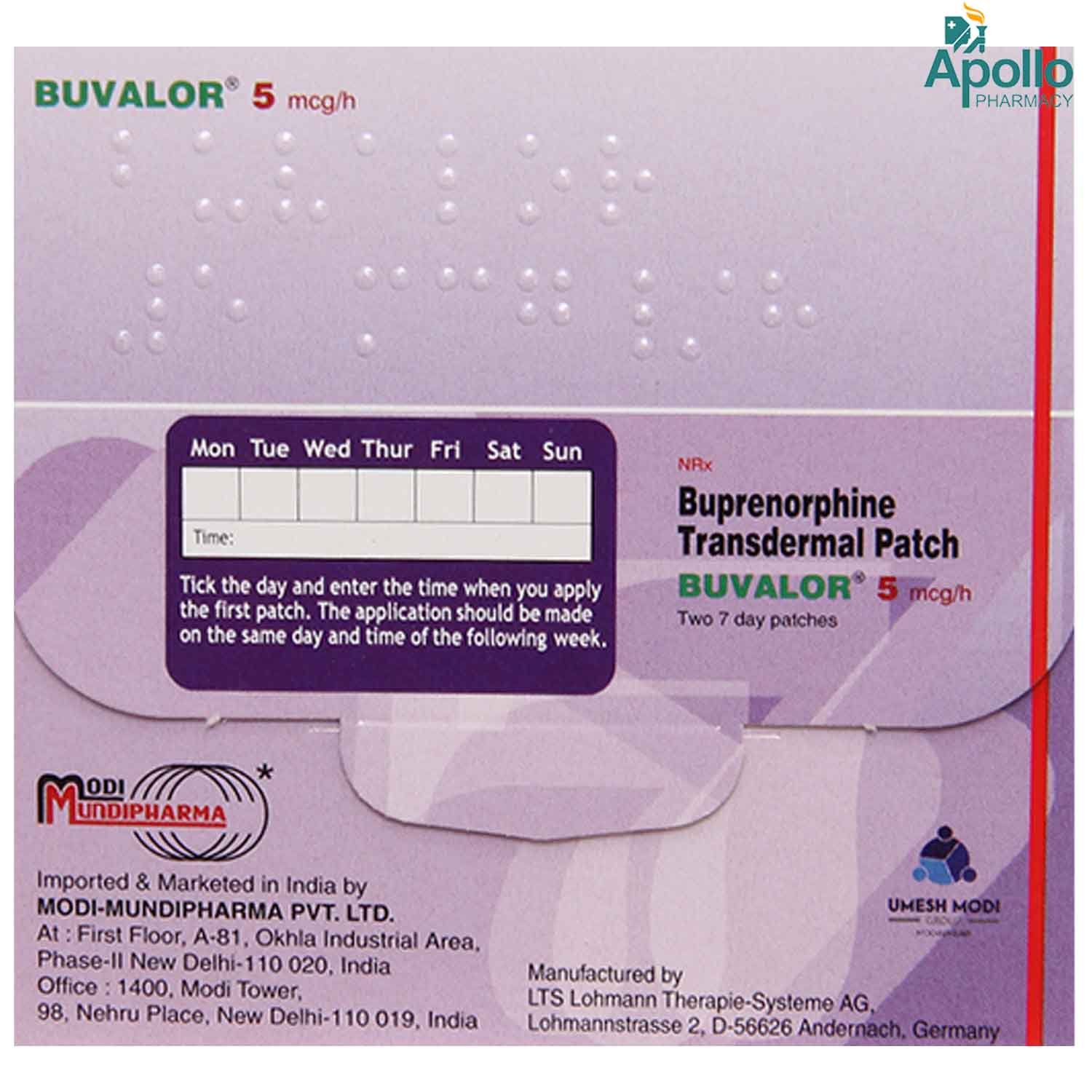Zuprinor 5 Transdermal Patch 1's


MRP ₹600.5
(Inclusive of all Taxes)
₹90.1 Cashback (15%)
Provide Delivery Location
Online payment accepted
 Prescription drug
Prescription drugWhats That
Composition :
Manufacturer/Marketer :
Consume Type :
Return Policy :
Expires on or after :
About Zuprinor 5 Transdermal Patch
Zuprinor 5 Transdermal Patch belongs to a class of drugs called 'opioid analgesics' primarily used to treat, prevent and treat severe pain. Pain can be temporary (acute) or long-lasting (chronic) in nature. Acute pain is caused by damage to the tissues of the muscle, bone, or other organs for a short time. Chronic pain lasts for a long duration and is caused due to pathologies like nerve damage and osteoarthritis.
Zuprinor 5 Transdermal Patch contains 'Buprenorphine', an opioid partial agonist-antagonists. It works by blocking a chemical messenger in the brain responsible for causing pain. This provides pain relief by acting on specific receptors in the brain and helps in relieving pain.
Use Zuprinor 5 Transdermal Patch as advised by your doctor. You may experience certain side effects in some cases, including drowsiness, dry mouth, vomiting, blurred vision, constipation, application site reactions, dizziness or tiredness. Most of these side effects do not require medical attention and gradually resolve over time. However, if the side effects persist or worsen, please consult your doctor.
Zuprinor 5 Transdermal Patch should be avoided if you are allergic to it or any ingredients of it or opioids. Do not use Zuprinor 5 Transdermal Patch if you are pregnant or breastfeeding. Zuprinor 5 Transdermal Patch is not recommended for children below 18 years of age. Zuprinor 5 Transdermal Patch is a habit-forming drug; hence there is a risk of dependence. Do not stop using this medicine without consulting your doctor, as it may cause withdrawal symptoms like anxiety, increased heart rate, tremors or general unwell feelings. Zuprinor 5 Transdermal Patch may decrease fertility in men and women. Do not consume alcohol while using Zuprinor 5 Transdermal Patch as it may increase the risk of side effects.
Uses of Zuprinor 5 Transdermal Patch
Directions for Use
Medicinal Benefits
The Zuprinor 5 Transdermal Patch contains Buprenorphine. It provides pain relief by acting on specific receptors in the brain and helps in relieving pain. Compared to other opioid analgesics like methadone, Zuprinor 5 Transdermal Patch has the advantage of having less sedation (sleepiness), decreased respiratory depression, decreased risk of diversion, fewer withdrawal symptoms and lower risk of toxicity at higher doses.
Storage
Drug Warnings
Please do not stop using Zuprinor 5 Transdermal Patch suddenly, as it may cause withdrawal symptoms. Avoid frequent or high doses as it may lead to addiction. If you are known to be allergic to Zuprinor 5 Transdermal Patch or any other medicines, please tell your doctor. Do not use Zuprinor 5 Transdermal Patch if you are pregnant or breastfeeding, as it may cause adverse effects on the baby. Zuprinor 5 Transdermal Patch is not recommended for children below 18 years of age. Avoid consuming alcohol with Zuprinor 5 Transdermal Patch as it may increase the risk of side effects. Do not use this medicine if you have used an MAO inhibitor (antidepressants) in the past 14 days, as a dangerous drug interaction could occur. Zuprinor 5 Transdermal Patch should be taken with extreme caution in patients who have a history of alcoholism or drug abuse. Inform your doctor if you have severe breathing problems, asthma, delirium tremens (confusion and shaking after stopping drinking alcohol), hallucinations (seeing and hearing things that are not there), kidney or liver problems, head injury or brain disease, low blood pressure, urinary disorders (especially linked to enlarged prostate), thyroid problems, adrenocortical disorder (Addison’s disease), depression or other conditions that are treated with antidepressants.
Drug-Drug Interactions
Drug-Drug Interactions
Login/Sign Up
Using alvimopan together with Zuprinor 5 Transdermal Patch can cause side effects (abdominal pain, nausea, vomiting, and diarrhea).
How to manage the interaction:
Taking Alvimopan with Zuprinor 5 Transdermal Patch is not recommended, consult a doctor before taking it. Do not stop using any medications without talking to a doctor.
Taking Ziprasidone with Zuprinor 5 Transdermal Patch can increase the risk of serious side effects.
How to manage the interaction:
Taking Ziprasidone with Zuprinor 5 Transdermal Patch is not recommended, but it can be taken together if prescribed by a doctor. However, consult a doctor if you experience dizziness, drowsiness, difficulty concentrating, and impairment in judgment. Do not discontinue any medications without consulting a doctor.
Taking Zuprinor 5 Transdermal Patch with escitalopram increases the risk of an abnormal heart rhythm.
How to manage the interaction:
Concomitant administration of Zuprinor 5 Transdermal Patch and escitalopram can result in an interaction, they can be taken together if prescribed by a doctor. However, consult a doctor if you experience sudden dizziness, lightheadedness, fainting, or shortness of breath. Do not discontinue any medications without consulting a doctor.
Using Hydroxyzine together with Zuprinor 5 Transdermal Patch can cause central nervous system depression (a physiological state that can result in a decreased rate of breathing, decreased heart rate, and loss of consciousness).
How to manage the interaction:
Co-administration of Zuprinor 5 Transdermal Patch alongside hydroxyzine can result in an interaction, it can be taken if a doctor has advised it. Do not exceed the doses, frequency, or duration of usage advised by a doctor. You should avoid driving or operating hazardous machinery until you're aware of how these medications affect you. Do not discontinue any medications without consulting a doctor.
Coadministration of Zuprinor 5 Transdermal Patch with Chlordiazepoxide can increase the risk or severity of side effects like decreased breathing rate, irregular heart rhythms, or problems with movement and memory.
How to manage the interaction:
Taking Zuprinor 5 Transdermal Patch and chlordiazepoxide together can result in an interaction, it can be taken if a doctor has advised it. However, if you experience drowsiness, shortness of breath, palpitations, numbness in hands and feet, or hypersensitivity to light and noise, consult a doctor immediately. Do not discontinue any medications without consulting a doctor.
Using arsenic trioxide together with Zuprinor 5 Transdermal Patch can increase the risk of an irregular heart rhythm.
How to manage the interaction:
Taking Arsenic trioxide with Zuprinor 5 Transdermal Patch together can result in an interaction, but it can be taken if a doctor has advised it. If you experience an irregular heart rhythm, a heart condition, a condition called congenital long qt syndrome, problems with your heart's electrical system, severe or long-lasting diarrhea, vomiting, complications, sudden dizziness, feeling lightheaded, fainting, difficulty breathing, or heart palpitations contact a doctor right away. Do not stop using any medications without a doctor's advice.
Coadministration of Morphine with Zuprinor 5 Transdermal Patch can increase the risk and severity of Morphine side effects
How to manage the interaction:
Taking Morphine with Zuprinor 5 Transdermal Patch can result in an interaction, it can be taken if a doctor has advised it. However, if you experience any symptoms like trouble breathing, feeling tired, or having a cough, dizziness, drowsiness, difficulty concentrating, and impairment in judgment, reaction speed, and motor coordination make sure to contact a doctor right away. Do not stop using any medications without consulting a doctor.
Taking ceritinib together with Zuprinor 5 Transdermal Patch can increase the risk of irregular heart rhythm.
How to manage the interaction:
Although there is an interaction between Zuprinor 5 Transdermal Patch and ceritinib, but can be taken if a doctor has advised it. However, if you experience sudden dizziness, lightheadedness, fainting, shortness of breath, or rapid heartbeat, contact a doctor immediately. Do not discontinue any medications without consulting a doctor.
Taking Zuprinor 5 Transdermal Patch with anagrelide increases the risk of an abnormal heart rhythm.
How to manage the interaction:
Concomitant administration of Zuprinor 5 Transdermal Patch with anagrelide can result in an interaction, it can be taken if a doctor has advised it. However, if you experience abrupt dizziness, lightheadedness, fainting, shortness of breath, or rapid heartbeat, get medical help immediately. Do not discontinue any medications without consulting a doctor.
Using Zuprinor 5 Transdermal Patch together with Eslicarbazepine can cause central nervous system depression.
How to manage the interaction:
Concomitant administration of Zuprinor 5 Transdermal Patch alongside eslicarbazepine can result in an interaction, but it can be taken if a doctor has advised it. Do not discontinue any medications without consulting a doctor.
Drug-Food Interactions
Drug-Food Interactions
Login/Sign Up
Diet & Lifestyle Advise
- Do not go for heavy exercise as it may increase your joint pain in arthritis. Instead, you can do stretching and low-impact aerobic exercises like walking on a treadmill, bike riding, and swimming. You can also strengthen your muscles by lifting light weights.
- Drink plenty of water during treatment with Zuprinor 5 Transdermal Patch to avoid dry mouth.
- Maintain a fibre-rich diet and eat plenty of fresh fruits and vegetables to avoid constipation while using Zuprinor 5 Transdermal Patch.
- Avoid consumption of alcohol and quit smoking.
Side Effects of Zuprinor 5 Transdermal Patch
- Weakness
- Anxiety
- Nervousness
- Dizziness
- Headache
- Constipation
- Diarrhea
- Nausea
- Vomiting
- Sweating
- Application site reactions
Habit Forming
Therapeutic Class
All Substitutes & Brand Comparisons
RX
Not for online saleBuvalor 5 mcg/h Transdermal Patch 2's
Modi Mundipharma Pvt Ltd
₹814.5
(₹366.55 per unit)
32% CHEAPERRX
Not for online saleBuprigesic 5mcg/Hr Transdermal Patch 2's
Neon Laboratories Ltd
₹1562.5
(₹703.15 per unit)
30% COSTLIERRX
Not for online saleBupreplast 5Mcg/Hr Transdermal Patch 2'S
Emcure Pharmaceuticals Ltd
₹1659
(₹746.55 per unit)
38% COSTLIER
Product Substitutes
Author Details
We provide you with authentic, trustworthy and relevant information
Drug-Diseases Interactions
Drug-Diseases Interactions
Login/Sign Up
FAQs
Zuprinor 5 Transdermal Patch consists of Buprenorphine is an opioid partial agonist. It provides pain relief by acting on specific receptors in the brain that change how your body feels and responds to pain.
No, you are not recommended to take Zuprinor 5 Transdermal Patch with antidepressants (medicines used to treat depression), and antipsychotics (medicines used to treat bipolar disorder and psychosis) as co-administration of these medicines with Zuprinor 5 Transdermal Patch may cause life-threatening respiratory depression and death have occurred. However, please consult a doctor before taking Zuprinor 5 Transdermal Patch with other medicines.
Yes, Zuprinor 5 Transdermal Patch may cause withdrawal symptoms such as sweating, feeling hot and cold, runny eyes and nose, feeling or being sick, diarrhoea, stomach cramps, poor sleep, and just feeling awful. Therefore, if you experience any difficulty while using Zuprinor 5 Transdermal Patch, do not stop using it suddenly and consult your doctor so that the dose may be reduced gradually to avoid withdrawal symptoms.
Yes, Zuprinor 5 Transdermal Patch may cause addiction, especially if taken for a prolonged time. Therefore, Zuprinor 5 Transdermal Patch should be given only for a short duration under strict medical supervision, particularly to patients susceptible to drug abuse. Take Zuprinor 5 Transdermal Patch only as advised by a doctor, as overuse or misuse of Zuprinor 5 Transdermal Patch can lead to overdose or death.
Drug-Drug Interactions Checker List
- ESCITALOPRAM
- CITALOPRAM
- METHADONE
- FLUOXETINE
- DIAZEPAM
- CODEINE
- MORPHINE
- AMITRIPTYLINE
- PROMETHAZINE
- VENLAFAXINE
Special Advise
- Do not use Zuprinor 5 Transdermal Patch for a prolonged time, as it may lead to mental or physical dependence on Zuprinor 5 Transdermal Patch.
- To avoid getting addicted to this drug, take it in prescribed quantities and as directed by your doctor. Do not self-medicate.
- Zuprinor 5 Transdermal Patch causes drowsiness. Avoid doing activities that require your complete focus and attention, like driving when on this drug.
- An abrupt stoppage of Zuprinor 5 Transdermal Patch can lead to significant withdrawal symptoms. Always discuss with your doctor about decreasing the dosage before completely stopping its usage.
- Avoid consuming alcohol while on this medication, as it can lead to dangerous side effects.
Disease/Condition Glossary
Pain: It can be short-term (acute) or long-term (chronic) in nature. Acute pain is, for a short time, caused by damage to the tissues of the muscle, bone, or organs. Chronic pain lasts for a longer duration and is caused due to pathologies like nerve damage, osteoarthritis, and dental pain due to damage to the tooth nerve, infection, decay, extraction, or injury. Many women have painful periods known as dysmenorrhea, most often menstrual cramps. On the other hand, Osteoarthritis is a degenerative disease that results in chronic pain in joints (especially knee) and stiffness, making daily tasks difficult.

Have a query?
Buy best C.n.s Drugs products by
Intas Pharmaceuticals Ltd
Sun Pharmaceutical Industries Ltd
Torrent Pharmaceuticals Ltd
Alkem Laboratories Ltd
Abbott India Ltd
Cipla Ltd
Alteus Biogenics Pvt Ltd
Micro Labs Ltd
Lupin Ltd
Ipca Laboratories Ltd
D D Pharmaceuticals Pvt Ltd
Icon Life Sciences
Mankind Pharma Pvt Ltd
Tripada Healthcare Pvt Ltd
Arinna Lifesciences Ltd
Linux Laboratories Pvt Ltd
East West Pharma India Pvt Ltd
La Renon Healthcare Pvt Ltd
Talent India Pvt Ltd
Tas Med India Pvt Ltd
Zydus Healthcare Ltd
Cnx Health Care Pvt Ltd
Eris Life Sciences Ltd
Leeford Healthcare Ltd
Emcure Pharmaceuticals Ltd
Macleods Pharmaceuticals Ltd
Sigmund Promedica
Aristo Pharmaceuticals Pvt Ltd
Dr Reddy's Laboratories Ltd
Troikaa Pharmaceuticals Ltd
Consern Pharma Ltd
Zydus Cadila
Shine Pharmaceuticals Ltd
Wockhardt Ltd
Ardent Life Sciences Pvt Ltd
Crescent Formulations Pvt Ltd
Theo Pharma Pvt Ltd
Reliance Formulation Pvt Ltd
Ikon Pharmaceuticals Pvt Ltd
Propel Healthcare
Neon Laboratories Ltd
Jagsam Pharma
Msn Laboratories Pvt Ltd
Morepen Laboratories Ltd
Pulse Pharmaceuticals
Sanofi India Ltd
Med Manor Organics Pvt Ltd
Hetero Healthcare Pvt Ltd
Novartis India Ltd
Crescent Therapeutics Ltd
Elder Pharmaceuticals Ltd
Solvate Laboratories Pvt Ltd
Akumentis Healthcare Ltd
Mova Pharmaceutical Pvt Ltd
Psyco Remedies Ltd
Tripada Lifecare Pvt Ltd
Ajanta Pharma Ltd
Cyrus Remedies Pvt Ltd
Medishri Healthcare Pvt Ltd
Cadila Healthcare Ltd
Glenmark Pharmaceuticals Ltd
Matteo Health Care Pvt Ltd
Hbc Life Sciences Pvt Ltd
Lyf Healthcare
Matias Healthcare Pvt Ltd
Mesmer Pharmaceuticals
Alembic Pharmaceuticals Ltd
Capital Pharma
Crescent Pharmaceuticals
Medopharm Pvt Ltd
Alniche Life Sciences Pvt Ltd
Kivi Labs Ltd
Talin Remedies Pvt Ltd
USV Pvt Ltd
Quince Lifesciences Pvt Ltd
Solis Pharmaceuticals
Infivis Life Care
Zuventus Healthcare Ltd
Cadila Pharmaceuticals Ltd
Pfizer Ltd
Wallace Pharmaceuticals Pvt Ltd
A N Pharmacia Laboratories Pvt Ltd
Blue Cross Laboratories Pvt Ltd
Jenburkt Pharmaceuticals Ltd
Lia Life Sciences Pvt Ltd
Mano Pharma
Medley Pharmaceuticals Ltd
Primus Remedies Pvt Ltd
FDC Ltd
Maneesh Pharmaceuticals Ltd
Apex Laboratories Pvt Ltd
Gagnant Healthcare Pvt Ltd
Ozone Pharmaceuticals Ltd
RPG Life Sciences Ltd
Strides Shasun Ltd
Unichem International
GlaxoSmithKline Pharmaceuticals Ltd
Kuresys Labs Pvt Ltd
LA Pharma
Trion Pharma India Llp
Alcohol
Unsafe
Consuming alcohol or other illicit drugs during treatment with Zuprinor 5 Transdermal Patch increases your chances of experiencing these significant, life-threatening adverse effects. Throughout your therapy, do not consume alcohol, use alcohol-containing prescription or nonprescription medicines, or use street drugs.
Pregnancy
Unsafe
If you are pregnant or planning pregnancy, inform your doctor. If you use Zuprinor 5 Transdermal Patch often throughout your pregnancy, your baby may suffer from potentially fatal withdrawal symptoms after birth. If your infant exhibits any of the following symptoms, contact your doctor straight away: irritability, hyperactivity, disturbed sleep, high-pitched scream, excessive shaking of a portion of the body, vomiting, diarrhoea, or failure to gain weight.
Breast Feeding
Unsafe
If you are nursing, you should avoid using Zuprinor 5 Transdermal Patch. Buprenorphine passes into breast milk in small amounts and might cause respiratory issues in your infant. Talk with your doctor; they may prescribe a different pain reliever.
Driving
Unsafe
Zuprinor 5 Transdermal Patch may cause dizziness, blurred vision or drowsiness in some people. Therefore, avoid driving if you feel drowsy, dizzy or experience any vision problems after using Zuprinor 5 Transdermal Patch.
Liver
Caution
If you have a pre-existing or a history of liver disease, inform your doctor before using Zuprinor 5 Transdermal Patch.
Kidney
Caution
If you have a pre-existing or a history of kidney disease, inform your doctor before using Zuprinor 5 Transdermal Patch.
Children
Unsafe
Zuprinor 5 Transdermal Patch is not recommended for children below 18 years of age as safety and effectiveness have not been established.






.jpg?tr=q-85)

